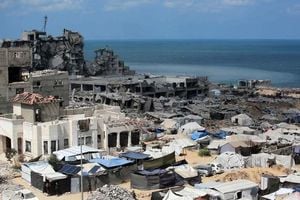On August 19, 2025, the United Nations drew the world’s attention to a grim milestone: a record 383 aid workers were killed worldwide in 2024, marking the highest death toll since records began in 1997. This staggering figure, reported by both Reuters and the Associated Press, underscores the mounting dangers faced by humanitarian staff in conflict zones, with the war in Gaza emerging as the deadliest arena for those dedicated to helping others.
According to the U.N. humanitarian office, nearly half of the aid worker deaths in 2024 occurred in Gaza and the occupied Palestinian territories. The ongoing conflict between Israel and Hamas, which erupted after the deadly cross-border attacks by Hamas-led militants on October 7, 2023, has transformed the region into the world’s most perilous workplace for humanitarian staff. The U.N.’s sobering report was released on the annual day honoring aid workers—an occasion meant to celebrate their courage but now overshadowed by a sense of crisis and loss.
Tom Fletcher, the U.N. Under-Secretary-General for Humanitarian Affairs, did not mince words in his condemnation. “Attacks on this scale, with zero accountability, are a shameful indictment of international inaction and apathy,” Fletcher stated, as cited by StratNews Global. His words carried the frustration and urgency felt by many in the humanitarian community, who see the rising toll not just as a statistic but as a call for global responsibility.
The numbers for 2025, though still provisional, suggest little respite. As of August 20, 2025, 265 aid workers have already lost their lives, with 173 of those deaths occurring in Gaza during Israel’s near two-year offensive against Hamas. The Aid Worker Security Database, a U.S.-funded platform that tracks major security incidents affecting aid workers, provided these sobering figures. Beyond Gaza, 36 aid workers have been killed in Sudan, and three in Ukraine this year, illustrating that the risks extend far beyond a single conflict zone.
One particularly harrowing incident in Gaza this past March drew international condemnation and highlighted the acute dangers aid workers face. In three separate shootings, 15 emergency and aid workers were killed by Israeli fire. Their bodies were subsequently buried in a shallow grave, a detail that shocked even seasoned observers of conflict. According to Reuters, this tragedy became emblematic of the broader hazards and the seeming impunity surrounding attacks on humanitarian staff.
Despite the protections theoretically afforded to aid workers under international humanitarian law, accountability remains elusive. Experts point to the rarity of cases going to trial, citing challenges such as the need to prove intent and concerns over maintaining future access for aid organizations. Jens Laerke, spokesperson for the U.N. humanitarian office, captured the mood succinctly, saying, “It is catastrophic, and the trend is going in right the opposite direction of what it should.”
The world’s humanitarian workers—doctors, nurses, logisticians, drivers, and countless others—are supposed to be shielded from the violence of war by the Geneva Conventions and related treaties. These legal frameworks enshrine their right to operate free from attack, recognizing the essential role they play in alleviating human suffering. Yet, as the record death tolls suggest, the letter of the law is increasingly ignored on the ground.
The Gaza Strip, in particular, has become a flashpoint for these violations. Israel’s offensive, launched in response to the October 2023 attacks, has seen repeated allegations of indiscriminate fire, restricted humanitarian access, and, as the numbers show, a devastating impact on those trying to deliver aid. Nearly half of all aid worker deaths in 2024 happened here, a statistic that lays bare the dangers of working amidst such intense and prolonged violence.
Sudan, too, has seen a spike in attacks on aid workers in 2025. With 36 deaths recorded so far this year, the country’s ongoing civil strife has created an environment where humanitarian staff are often caught in the crossfire or deliberately targeted. Meanwhile, Ukraine, despite the world’s focus on its broader conflict with Russia, has seen three aid worker fatalities in 2025—a reminder that even in less-reported crises, those who help are not immune from harm.
The international community’s response to these mounting casualties has been, at best, uneven. While statements of condemnation and calls for accountability are routine, actual prosecutions or meaningful investigations remain rare. Experts note that the difficulty in proving intent behind attacks, coupled with the political sensitivities of prosecuting armed forces or state actors, means that most cases never reach a courtroom. Aid organizations themselves often hesitate to push for legal action, fearing that it might jeopardize their ability to operate in hostile environments.
For the families and colleagues of those killed, the lack of justice adds another layer of pain. The annual day honoring aid workers, which should be a time of celebration and gratitude, has instead become a day of mourning and reflection. As Edith M. Lederer reported for the Associated Press, this year’s commemorations were marked by a sense of urgency—a collective demand that the world do more to protect those who risk everything to help others.
Behind every statistic is a story of courage and sacrifice. The 383 aid workers killed in 2024 were not just numbers on a spreadsheet; they were individuals who chose to step into danger for the sake of others. Their loss is felt not only by their families and organizations but by the communities they served—often the world’s most vulnerable people, left even more exposed when humanitarian operations are forced to scale back or suspend activities due to security concerns.
The rising toll has prompted renewed calls for action. Advocates urge governments and armed groups alike to respect international humanitarian law and to ensure that those who attack aid workers are held accountable. There are also appeals for better training and security protocols for humanitarian staff, though many acknowledge that no amount of preparation can fully eliminate the risks in today’s conflict zones.
The situation in Gaza remains especially dire, with no clear end in sight to the violence. As the Israeli offensive continues and humanitarian needs mount, aid workers are forced to make impossible choices every day. Do they press on, knowing the dangers, or pull back and risk abandoning those who depend on them? It’s a question with no easy answers, but one that speaks to the heart of the humanitarian mission.
As the world marks another year of record casualties among aid workers, the calls for accountability and protection grow ever louder. Whether those calls will be heeded remains to be seen. For now, the grim statistics serve as a stark reminder of the price paid by those who choose to help—and of the world’s collective responsibility to do better.



